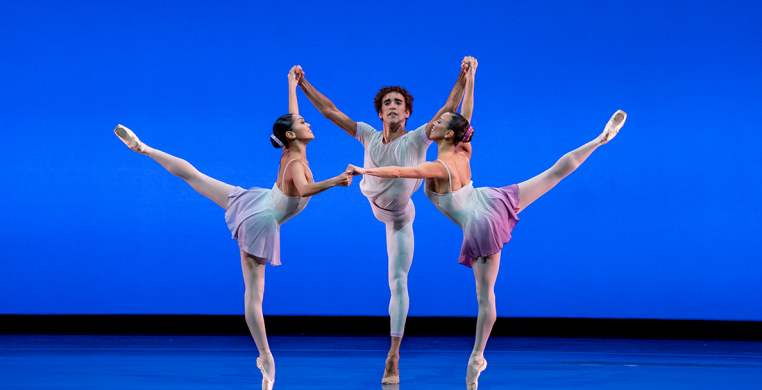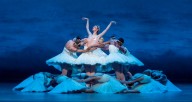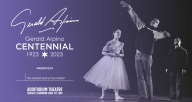The Joffrey Ballet’s bold move from New York City to Chicago in 1995 both saved the company and transformed Chicago from a sleepy touring stop for national companies to a thriving national and international dance capitol. Joffrey built a new home for itself, and others followed, just like in the baseball movie “Field of Dreams.”
That story is poignantly told in Bob Hercules’ 2012 film, Joffrey: Mavericks of American Dance, shown on Saturday, September 18th at the Gene Siskel Film Center.
Joffrey Ballet alums, many of whom were in the audience at The Film Center, had flocked to Chicago from near and far for the weekend-long Gerald Arpino Centennial Celebration.
The film tells the story of The Joffrey Ballet, its founding directors, Robert Joffrey and Gerald Arpino, and their journey as artists who exemplified the highest standards of creative integrity. Their refusal to capitulate in the face of seemingly insurmountable obstacles framed one of the principal messages of the film and infused the entire weekend’s events, which culminated in two all-Arpino performances at the Auditorium Theatre.
I am still metabolizing the avalanche of emotion and images from the day I spent immersed in The Joffrey. What sticks with me is hope. I am filled with hope, even in the perilous national and international political climate in which we now exist. Hope. Why? Because dance, and all the performing arts, have the power to transform people’s hearts and minds, and to change the world. It may seem overly optimistic to make such an assertion, but history attests to it. We have only to look at Impressionism in the mid-19th Century, and Diagilev’s Ballets Russes in early 20th-century Paris, Picasso’s Guernica, Stravinsky’s The Rite of Spring, or Kurt Joos’s The Green Table to see the revolutionary effect of the arts on people’s awareness, political activism, and public policy.
But back to The Gerald Arpino Centennial Celebration—how does one even begin? What words can capture the irony between what we witnessed on stage and the world that awaited us as we exited the theatre? No words are needed, however, because at the end of the curtain calls for each of the five companies, and the combined bows of all the dancers who performed that night, Victoria Jaiani emerged from the mass of dancers onstage with her arm outstretched, a votive candle in the palm of her hand. Jaiani, the only current Joffrey Company member who was in the company when it moved to Chicago, extended her arm toward the house-right first balcony, where a spotlight illuminated the box seat from which Mr. Arpino watched his dancers perform.
Program A on Saturday night consisted of Arpino works in the repertoires of five different companies, offering something for everyone. But first, a disclaimer. I had come to the Auditorium Theatre from seeing Hercules’ fabulous documentary film subtitled, “Mavericks,” that told the story of Robert Joffrey and Gerald Arpino’s daring transformation of traditional ballet, creating choreography that was “dangerous,” subjects that were “political,” and putting “ideas” on stage. “They had grit,” one alum said. “They were committed to creating a truly American ballet company.”
I entered the Auditorium Theatre that evening expecting to see Arpino’s “grit” and “truly American,” choreography that was deemed so “dangerous” in Bob Hercules’ film. Two of the five works on Program A qualified, but the two pas de deux and one quintet were an unexpected example of Arpino’s choreographic versatility not only as modernist but as classicist as well. My personal bias unabashedly favors the modernist.
 Katlyn Addison and Hadriel Diniz of Ballet West perform "RUTH, Ricordi per Due"; Photo by Cheryl Mann Productions
Katlyn Addison and Hadriel Diniz of Ballet West perform "RUTH, Ricordi per Due"; Photo by Cheryl Mann Productions
If you love traditional classical ballet, Oklahoma City Ballet’s rendition of the frothy Birthday Variations (1986), was for you. Set to the music of Giuseppe Verdi, the piece began as a visual representation of a birthday cake, with four ballerinas in delicious flavors of frosting surrounding the one male dancer, the “candle” on the cake. All the requisite opportunities for each of the ballerinas to show off her technical facility and coquettish allure are present, with the “candle” (Alejandro Gonzáles) stepping in now and then to support a pirouette, effortless lift overhead, or daring fish-dive. He earned his keep with some impressive brisées volés and leaps in a solo variation. Birthday Variations was a tasty appetizer that didn’t challenge one to think, or to feel much more than a sugar high.
In stark contrast, American Ballet Theatre’s Hee Seo and Cory Stearns awakened into an impressionistic underwater world in the modernist Sea Shadow (1962). The dancers' sensuality and mutual discovery had a dreamy, timeless quality, set to music by Maurice Ravel. Swimming gestures on the floor brought them to their feet and back to the floor, their bodies floating on watery currents. The unity of music and movement became a choreographic song without words, the dancers exploring the joining and separating of their bodies in the fluid timelessness of water.
“L’Air D’Esprit” (1978), set to music by Adolphe Adam, verged on becoming a parody of itself, catapulting us back into 19th century ballet classicism. San Francisco Ballet’s Misa Kuranaga’s fancy footwork brought to mind needlepoint stitching on fast-forward speed. Her partner Wei Wang’s calves rebounded like lacrosse balls in crisp beats to match Kuranaga’s industry, but their partnership had some bumpy landings. Together they were a perfect example of dancers whose impressive technical tricks failed to inspire.
Ballet West’s staging of RUTH, Ricordi per Due (2004) is an elegy for Robert Joffrey, although commissioned to honor its benefactor’s mother. It was Arpino’s final work, a psychological drama with a depth of contemporary moves that challenged the viewer in the best of ways to really pay attention. Here was the innovative Arpino the film promised, the artist who broke convention to represent the complex psychology of relationship and loss.
The sorrowful strains of Albinnoni’s Adagio in G Minor began the piece on a funereal organ chord and continued with strings in a lachrymose lament. Hadriel Diniz, downstage in a Rodin-like “Thinker” pose, imagines the lover he has lost, portrayed by Katlyn Addison, inanimate in an upstage corner. He conjures her image back to life for a brief and nuanced duet of exquisite partnering. Addison’s presence is both there and not there, her body animating costume designer Maria Pinto’s stunning long-sleeve white gown with nuanced impulses. The dress is a costume, prop, and moving set, all in one, incorporating a visual design element literally into the fabric of the choreography. She disappears into its voluminous skirts, as if behind a giant fan, wraps him in it and unfolds herself from it. She becomes stiff in his arms as he holds her horizontally across his hips like a piece of wood. In the end, she slips away and drifts back into oblivion, while he returns to his pensive pose.
Our own wonderful Joffrey Ballet Company closed the program with Suite Saint-Saëns (1978). A stage full of crisp sauté arabesques and fouetté sautés in geometric spatial designs painted an immediately contemporary stage picture. Torso impulses propelled the dancers from their centers, sending them on and off stage in constant energy exchange. Six men performed cabrioles and pirouettes in perfect sync only to be rushed offstage by six ladies in unison flow. Swinging torsos and limbs explored the fall and recovery of breathy modern dance. Victoria Jaiani and Dylan Gutierrez were especially radiant in a pas de deux in the minuet section, a great example of Arpino’s use of the form to expand the man’s role as an integral element of choreographic design and not simply the ballerina’s prop.
The Joffrey Ballet has made Chicago our field of dreams, and yes, a source of hope for us all. Thank you, Mr. Arpino, and The Arpino Foundation for this gift!



